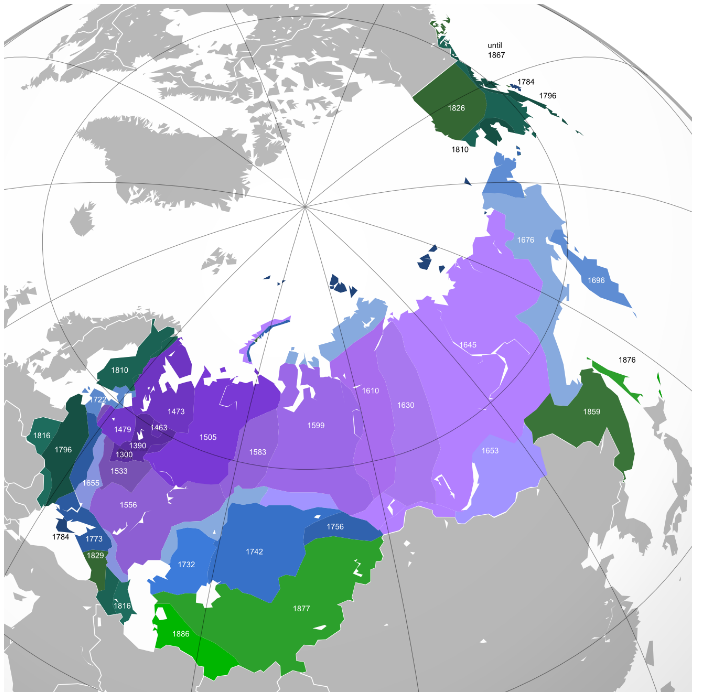3.3: Russian History and Expansion
- Page ID
- 131879
Russia’s current geographic landscape has been shaped by physical features, such as climate and topography, as well as historical events. Why is the capital of Russia Moscow, and why is its population so clustered in the west? In the 13th century, Moscow was actually an important principality, or city-state ruled by a monarch. The Grand Duchy of Moscow, or Muscovy as it was known in English, became a powerful state, defeating and surrounding its neighbors and claiming control over a large portion of Rus’ territory, an ancient region occupied by a number of East Slavic tribes. The Slavs represent the largest Indo-European ethnolinguistic group in Europe and include Poles, Ukrainians, Serbs, as well as Russians.
From the mid-1400s onward, the Muscovite territory expanded at an impressive rate (Figure \(\PageIndex{1}\)). In 1300 CE, the territory occupied an area of around 20,000 square kilometers. By 1462 CE, that number increased to 430,000 square kilometers. By 1584 CE, the territory had swelled to 5.4 million square kilometers.

During this time, Russia’s government shifted as well. In 1547 CE, Grand Duke Ivan IV, better known as “Ivan the Terrible,” crowned himself the first Tsar. The term tsar, also spelled czar, stems from the Roman title “Caesar” and was used to designate a ruler, much like the term “king” or “emperor.” Ivan IV nearly doubled the territory of Russia during his reign, conquering numerous surrounding ethnic groups and tribes.
Russia’s status as an “empire” dates back to the 1700s under the rule of Peter the Great. Peter was able to conquer Russia’s northwestern regions, establishing eastern seaports and founding the forward capital of Saint Petersburg along the Baltic Sea. A forward capital is a capital that has been intentionally relocated, generally because of economic or strategic reasons, and is often positioned on the edge of contested territory. Overall, the reforms of Peter the Great transformed the country and made it more similar to Western Europe.
The conclusion of World War I coincided with the end of the Russian Empire. The Russian Army fared poorly in the war, with approximately 1.7 million casualties. Russia’s people felt that the ruling class had become detached from the problems of everyday people and there were widespread rumors of corruption. Russia went through a rapid period of industrialization, which left many traditional farmers out of work. As people moved to the cities, there was inadequate housing and insufficient jobs. The economic and human cost of World War I, coupled with the plight of workers who felt exploited during the Industrial Revolution, ultimately led to the overthrow of Nicholas II who, along with his family, was imprisoned and later executed.
Eventually, the Bolsheviks, a Marxist political party led by Vladimir Lenin, overthrew the interim government and created the Union of Soviet Socialist Republics, abbreviated as the USSR and sometimes simply called the Soviet Union. The capital was also moved back to Moscow from Saint Petersburg. After Lenin’s death in 1924, Joseph Stalin took control and instituted both a socialist economy and collective agriculture.
Ideally, the changes the Bolsheviks supported were intended to address the failures of Nicholas II providing more stable wages and food supplies. Rather than have individual peasant farms that had limited interconnections and poor systems of distribution, the state would collectivize farming with several farming families collectively owning the land. Under a command economy, the production, prices of goods, and wages received by workers is set by the government. In the Soviet Union, the government took control of all industries and invested heavily in the production of capital goods, those that are used to produce other goods, such as machinery and tools. Though this system was intended to address concerns and inequalities that had developed under the tsars, the Soviet government under Stalin was fraught with its own economic and social problems.
- Slavs:
-
an ethnolinguistic group located in Central and Eastern Europe that includes West Slavs (such as Poles, Czechs, and Slovaks), East Slavs (including Russians and Ukrainians), and South Slavs (namely Serbs, Croats, and others)
- Forward Capital:
-
a capital that has been intentionally relocated, generally because of economic or strategic regions, and is often positioned on the edge of contested territory
- Bolsheviks:
-
a Marxist political party led by Vladimir Lenin that overthrew the interim government following the Russian Revolution and created the Union of Soviet Socialist Republics
- Command Economy:
-
an economic system where the production, prices of goods, and wages received by workers is set by the government

